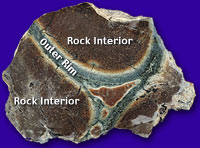INTRODUCTION | RED SEA “HOT BRINES” | METAL-RICH SEDIMENTS | SEAFLOOR ROCKS | OPHIOLITES | “MISSING HEAT”
Seafloor Rocks With Curious Chemistry A rock sample, recovered by drilling 116 meters below the active seafloor hydrothermal vent site at 26°N on the Mid-Atlantic Ridge, shows how the rock has been altered by reactions with seawater at temperature of about 300°C. Pieces of highly altered rock (gray) are cemented together with minerals such as iron sulfides (gold colored) and quartz (white). |
Rocks dredged up from the bottom of the sea also contained telltale clues. Most rocks from the mid-ocean ridge are black in color, with some white and pale green crystals. But, in the late 1960s and early 1970s, scientists found mid-ocean ridge seafloor rocks with unusual shades of green, orange, and brown.
Scientists figured out why these rocks were different by analyzing the minerals in the rocks, their crystalline structure, and their chemical composition. They concluded that the original black rocks had been transformed by chemical reactions that could only have taken place in the presence of hot water.
Much the way detectives might use clues to reconstruct how a crime occurred, the scientists figured out how the rocks probably formed. Cold seawater seeped into cracks in the seafloor and was warmed by heat from below. The hot water reacted and exchanged chemicals with seafloor rocks. The chemical reactions changed the minerals in the rocks and added minerals to the seawater. Because hot fluids—like hot air—is lighter and rises, the scientists predicted that mineral-rich fluids would rise back to the surface and discharge at the seafloor. They predicted that hydrothermal vents might exist, even before any had been seen.
| Ophiolites |

